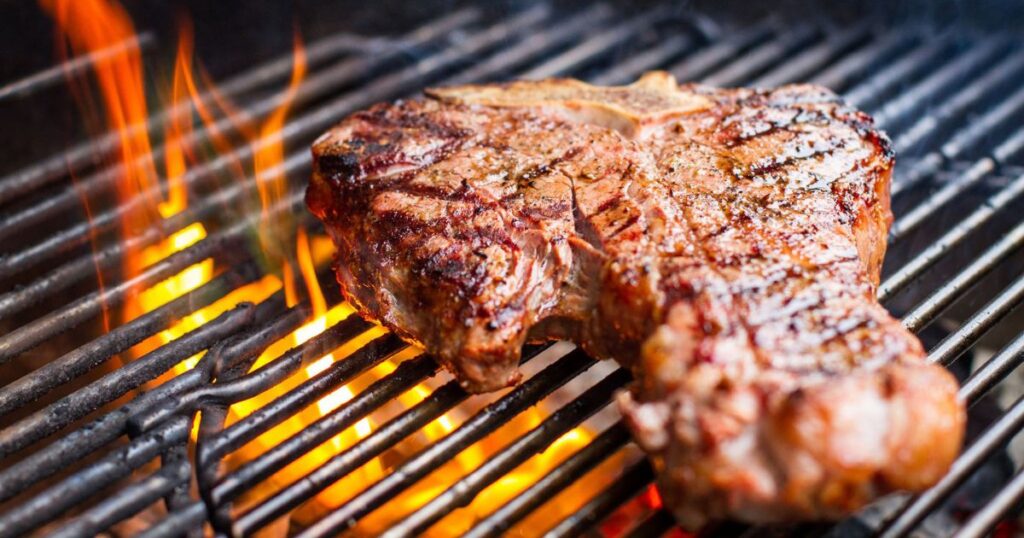Take your porterhouse out of the fridge 30 minutes early. Steak. Heat a pan on high, then sear each side for a deep brown crust. Flip it once, about 4 minutes per side for medium-rare. Want more flavor? Add butter, garlic, and herbs near the end. Let it rest 5 minutes before slicing – patience is key! Enjoy your juicy masterpiece!
How To Cook Porterhouse Steak On The Stove? Look no further than your stovetop! Forget fancy grills, tonight’s sizzling star is a perfectly cooked porterhouse. Imagine, tender bites bursting with flavor, a golden crust begging to be devoured. All it takes are simple steps and a few secrets. Ready to impress? Let’s fire up that pan and turn your kitchen into a steakhouse haven!
For a sizzling stove-cooked Porterhouse, grab your steak 30 minutes early to warm up. Season it well, then heat a cast-iron skillet till smoking hot. Sear each side for 4-5 minutes for a perfect crust. Slice off the bone, add butter and herbs to the pan, and nestle the steak back in. Cook another 4-7 minutes for medium-rare, then let it rest for 5 minutes before enjoying a restaurant-worthy meal at home!
Ingredients:
- 1 porterhouse steak, about 1 1/2 inches thick
- Salt and pepper, to taste
- Olive oil or butter
- Optional: garlic, thyme, or rosemary for additional flavor
Equipment:
- Cast-iron skillet or heavy-bottomed pan
- Tongs
- Meat thermometer (optional but recommended)
Instructions:
Bring the Steak to Room Temperature: Take the porterhouse ste-ak out of the refrigerator at least 30 minutes before cooking to allow it to come to room temperature. This ensures even cooking.
Season the Steak
The humble salt and pepper combo is a classic, but to truly elevate your porterhouse ste-ak, delve deeper into the world of seasoning. Start with generous kosher salt applied 30 minutes before cooking, allowing it to enhance the meat’s natural flavors.
For deeper penetration, dry brining with salt for an hour before searing works wonders. Black pepper is a must, but explore beyond the basics! Experiment with paprika, garlic powder, or even steak seasoning blends, adding them in layers after the salt. Fresh herbs like rosemary or thyme bring a fragrant touch, rubbed directly onto the steak or blended with salt and pepper. Remember, season all sides and adjust to your taste. With these tips and a dash of creativity, your porterhouse steak will transform into a flavor masterpiece!
Preheat the Pan
The searing process hinges on a scorching hot pan – it’s the key to locking in juices and creating that coveted crust. Choose a heavy-bottomed pan like cast iron for even heat distribution. Blast it over medium-high heat for 5-7 minutes, testing if it’s ready by flicking water droplets that sizzle and evaporate instantly. Finally, swirl in a high smoke point oil like canola or avocado. Remember, patience is key – don’t add oil until your pan is truly hot to avoid burning. With this fiery foundation, your ste-ak is set to shine!
Cook the Steak
Your pan is sizzling, your ste-ak is seasoned, now comes the moment of truth: the sear. Place the steak gently in the pan and resist the urge to fidget! Let it sizzle undisturbed for 3-4 minutes per side, building that beautiful brown crust. Remember, temperature is king – use a thermometer to ensure doneness, aiming for rare at 130°F, medium-rare at 135°F, and so on. For extra richness, baste with melted butter or a fragrant herb butter during the final minutes. Thick cuts might benefit from a quick oven finish to reach perfect internal temperature. With these tips and a watchful eye on the thermometer, you’ll be searing like a pro, ready to savor a juicy and flavorful porterhouse masterpiece!
Flip the Steak
Achieving a restaurant-worthy sear requires more than just heat. Flipping your porterhouse at the right moment is key to a beautiful crust and even cooking. Once the first side boasts a rich brown crust, confidently flip using sturdy tongs. Patience is crucial – resist the urge to fidget, letting the steak release naturally from the pan. Aim for 3-4 minute intervals per side for even cooking and a well-developed crust. Remember, less is more when it comes to flipping; trust the heat and let it work its magic. With this finesse, your porterhouse will transform from seasoned slab to a masterpiece of sizzling perfection.
Rest the Steak
Once the steak reaches the desired doneness, remove it from the pan and let it rest for 5-10 minutes. This allows the juices to redistribute, resulting in a juicier ste-ak.
Slice and Serve
The sizzling has subsided, your ste-ak is cooked to perfection, but the journey isn’t over yet. Resting is key! Tent the steak loosely and let it breathe for 5-10 minutes, allowing the juices to redistribute for maximum tenderness and flavor. Now, the moment of truth: slicing. Identify the grain and use a sharp knife to cut against it, creating thin, melt-in-your-mouth pieces. Whether you prefer classic 1/2-inch slices or delicate slivers, tailor it to your taste.
Finally, the reward! Plate your masterpiece alongside your favorite sides and sauces. Enjoy the symphony of flavor and texture in every bite, a testament to your culinary skills. Rest assured, this porterhouse experience will leave you and your guests wanting more!
Tips:
- For a smoky flavor, you can sear the steak in a hot pan and then finish cooking it in a preheated oven at 400°F (200°C) until it reaches the desired doneness.
- Use a meat thermometer to ensure your steak is cooked to your liking. The USDA recommends a minimum internal temperature of 145°F (63°C) for safety.
- Letting the steak rest after cooking is crucial as it allows the juices to redistribute, resulting in a more tender and flavorful steak.
FAQS
How long do I need to cook my porterhouse ste-ak for medium-rare?
For a 1-inch thick steak, cook for about 4 minutes per side for medium-rare. Thicker ste-aks may require slightly longer cooking times. Use a meat thermometer to check internal temperature: 130°F for rare, 135°F for medium-rare, 145°F for medium.
What’s the best pan to use?
Cast iron skillets are ideal for their excellent heat retention and ability to sear beautifully. Heavy-bottomed stainless steel pans also work well.
Should I use oil or butter to cook my ste-ak?
You can use either. Opt for high smoke point oils like canola or avocado oil for searing. For extra richness, add butter or herb butter towards the end of cooking.
How important is it to rest the steak?
Absolutely crucial! Resting allows the juices to redistribute, resulting in a significantly juicier and more flavorful steak. Aim for 5-10 minutes before slicing.
Can I add extra flavorings?
Absolutely! Experiment with seasonings like garlic powder, paprika, or steak blends. Fresh herbs like rosemary or thyme add a fragrant touch. Basting with herb butter during the final minutes is another delicious option.
Bonus Tip: Let your steak come to room temperature before cooking for even cooking and better results.
Remember, these are just general guidelines. Adjust cooking times and seasonings based on your steak’s thickness and personal preferences. Happy cooking!
Conclusion
So, you’ve conquered the sizzle, savored the smoky aroma, and mastered the delicate art of resting your steak. Now, the moment you’ve been waiting for: indulgence! Plate your masterpiece alongside your favorite sides, whether it’s creamy mashed potatoes, a refreshing salad, or roasted vegetables. With each bite, relish the symphony of flavors and textures – the tender steak bursting with juices, the golden crust a testament to your culinary prowess. This porterhouse experience isn’t just a meal; it’s a triumph.
But the journey doesn’t end there. Share your newfound skills and impress your loved ones with restaurant-worthy steaks at home. Remember, practice makes perfect, and each sizzling sear takes you closer to steakhouse mastery. So fire up your stove, experiment with seasonings, and embrace the joy of cooking. With dedication and these handy tips, you’ll be turning out perfect porterhouses in no time, leaving a lasting impression on every palate you grace.
Finally, remember, cooking is a journey of exploration and discovery. Don’t be afraid to experiment with different techniques, seasonings, and side dishes. The possibilities are endless, and with each culinary adventure, you’ll refine your skills and expand your culinary repertoire. So, grab your next porterhouse, embrace the sizzle, and embark on a journey to become a true steakhouse champion!
click on this to get more information “How To Cook Tomahawk Pork Chops?:


